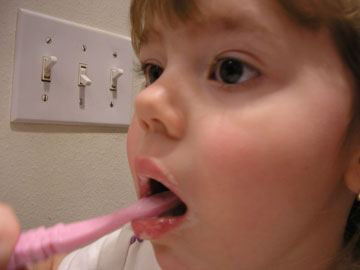 |
|
|---|
| |
|---|
|
|

|
Contents:A Modern History of Tooth BrushingSelecting a ToothbrushSelecting a Toothpaste For Tooth BrushingThe Place of Flossing in Tooth BrushingHow to Brush Your Teeth - Tooth Brushing Instructions / Technique |
A modern history of tooth brushing:
Brushing teeth is no simple process any more. As science and dentistry have progressed, much has been learnt about the bad consequences of earlier tooth brushing practices, with the result that many of us today are now considered to be brushing our teeth the wrong way, even though it was the way we were taught to brush our teeth as children.
One way we were taught to brush our teeth was to use a hard tooth brush, so that the bristles would get in between the teeth and get rid of plaque quicker from the teeth as well.
Of course, we all came to realize that the bigger the toothbrush head was, the faster we could brush our teeth.
The other common practice we were taught about tooth brushing was to use long, horizontal brushing strokes - the back and forth strokes across the teeth; like using a saw.
Well, science and dentistry and time have shown these common tooth brushing practices may benefit our teeth in the short term, but such tooth brushing also does drastic damage to the teeth:
The hard bristles of a hard tooth brush cuts through the enamel of teeth after many years of regular brushing.
Brushing teeth too hard or brushing teeth too much, has also been found to be bad for the teeth in the long run - tooth enamel just wasn't designed for that much wear and tear over many years.
The long hard horizontal strokes of the tooth brushing acts like a saw against the teeth, so the teeth may look fine in a mirror, but as they fall out or intense pain sets in, we find out out from a dentist that a groove has been worn through the base of the teeth, compromising the teeth. The dentist will then likely advise you to use desensitizing tooth paste, soft tooth brushes, gentle tooth brushing and a different way of brushing. Essentially though, your teeth were badly damaged by trying to clean them the wrong way by today's dental standards.
Selecting a Toothbrush:
First, forget about hard bristle or medium bristle toothbrushes - only soft bristled toothbrushes with rounded edges should be used, as they are less likely to damage the teeth.
Small headed toothbrushes are preferred over longer headed toothbrushes, as the smaller headed toothbrushes brush teeth cleaner and easier.
The best type of toothbrush looks like this:

You can buy such soft and small tooth brushes for around $5 at your local supermarket. If you have sensitive teeth, that is teeth that react to heat or cold without any teeth decay, then a super soft one, such as Dr Katz's $3 one, can be bought online and may be the best one for you.
Selecting a Toothpaste For Tooth Brushing:
There are lots of toothpastes being sold, choosing the right ones are really important as they give the teeth added protection.
1.. Look for toothpastes with added fluoride, as the fluoride can penetrate the enamel and strengthen the enamel considerably, which then protects the tooth much better from decay.
2.. Tar-tar control, anti plaque fluoride toothpaste is even better, as it helps to clean the teeth really, really well, removing all the plaque you can get at with the toothbrush and it strengthens the teeth at the same time.
3... Toothpastes with added mouth wash ingredients help kill any germs that may stay on the teeth following brushing.
4... Long acting toothpastes provide several hours of protection against plaque, following tooth brushing.
The best toothpaste to use is one that combines all of the above characteristics.
The Place of Flossing in Cleaning Teeth and Tooth Brushing:
It is recommended by dentists, that flossing occurs at least once once each day. The flossing of the teeth is normally conducted just prior to the night time tooth brushing.
Flossing is the way we brush between the teeth, therefore flossing helps us to clean our teeth much better than just tooth brushing alone.
Flossing is the act of placing a thin and preferably waxed string (floss) between the grooves which separate the teeth, then sliding the floss gently to and fro and up and down in one motion - repeat if debri is still stuck between the teeth.
More specifically, with the floss grapsed firmly, gently push it down between your teeth and scrape it up and down the sides of the adjoining teeth just once - too much flossing can saw your teeth as well.
Bleeding following flossing is common when just starting out. Often the gums have a mild infection from not being cleaned that you don't even know about. The inflamation / infection normally subsides with flossing, as flossing removes the debri which is the real culprit causing the bleeding problem to the gum.
If the teeth are really close together, flossing may be very difficult as the floss will get stuck in the tiny gaps. Your dentist may advise you what to do: If you are not one for flossing, then the dentist may advise you not to bother, but if you really do want to floss, your dentist may gently file the gap between your teeth a bit wider to take the floss more easily between them.
Not cleaning in between the teeth is now a leading cause of teeth disease, including periodontal disease. You should be aware of this before you make the decision not to floss!
If non-waxed floss is used, the floss will get stuck much easier between the teeth.
There are two types of teeth flossing / cleaning products around now.
1.. There is the classic real of floss
and you break about 30 centimeters, 12 inches off, wrap most of the floss around a finger on one hand and a smaller amount of the floss around the finger on the other hand and then move the floss up and down and in and out. If the floss gets too dirty or frayed, you just roll more floss from the finger with the most unused floss, wind the used bit onto the other finger and then floss some more. This type of flossing is a bit clumsy and bit time consuming, but worked pretty well. The piece of floss is discarded after the teeth cleaning is over.
2.. Then there are the more modern flossing teeth cleaning tools, called floss picks, which come in two varieties:
a.. The throw away is just a dental floss pick that you throw out after one flossing of the teeth, as shown below in the photo / picture:

b.. The other variety allows you to have a nice handle like that of a toothbrush and the floss pick head sits on the end of it. When the daily flossing is over, the floss pick head is discarded and a new floss pick head reinserted. Shown in the picture / photo below:

The next picture is of the floss pick head from the above unit, which is discarded after flossing between all the teeth:

With floss picks, teeth cleaning is achieved by moving the floss pick essentially up and down between the teeth, with some sideways movement to get it back out, making sure to move the floss below the gum line a fraction.
The throw away floss picks or floss heads are discarded after every flossing, as is the classic piece of floss, so as to prevent bacteria growth on the floss that may then infect the mouth area during another flossing. In practice though, dental hygienists believe that such infection is a remote possibility and suggest that if the floss head or pick is in good condition, to just rinse and reuse it next time.
If the gap between the teeth is a bit wide, such as may happen when periodontal disease has been active, then teeth cleaning also involves an additional step of using an interbrush. An interbrush is like a miniaturized bottle brush - it comes in about three sizes and you choose the size that suits your gap. You push the interbrush into the gap between the teeth, right on the gum line, then gently slide it in and out a few times, say 3 to 5 times. This cleans out the area at the gum line the flossing would have missed with wide gapped teeth.
Tooth Brushing Instructions
or How to Brush Your Teeth:
Science and dentistry have determined that there are only two techniques that work to brush your teeth reasonably safely. The tooth brushing technique I am mentioning here is the one that I consider to be the safest for tooth brushing and cleaning.
Horizontal strokes along the backs and fronts of the teeth is now a definite no no - gentle, long, horizontal strokes can be used on the grinding areas of the teeth and this is still the suggested practice for the grinding areas.
However, for cleaning the fronts and backs of the teeth, hold the tooth brush as you normally would for cleaning the fronts and backs of the teeth, but instead of using horizontal strokes, gentle, vertical strokes of the tooth brush is preferred. That is up and down strokes of the tooth brush have been found to be less harmful to the teeth. The up / down tooth brushing strokes can be done simply by just twisting the wrist, rather than just moving the hand up and down, which may exert too much force through the tooth brush.
Also, be sure to gently brush the gums - gum brushing is an important part of tooth brushing, as it cleans the gums, helps kills the germs on the gums and improves blood flow to the gums which also increases the amount of blood available to the teeth to draw nourishment from.
Gently brushing the tongue and underneath the tongue is also considered to be a good teeth brushing practice, as it cleans the tongue, kills the germs and helps reduce bad breath.
Teeth should be brushed twice every day, preferably after the morning meal and before going to bed, some dentists also suggest brushing the teeth after the lunch time meal.
The photo of the young girl brushing her teeth is courtesy of ccmackay
But first, if you want to come back to www.toothandteeth.com again, just add it to your bookmarks or favorites now! Then you'll find it easy!
Also, please consider sharing our helpful tooth and teeth website with your online friends.
contact us privacy policy legal disclaimer
Copyright © 2005-present Donald Urquhart. All Rights Reserved. All universal rights reserved. Designated trademarks and brands are the property of their respective owners. Use of this Web site constitutes acceptance of our legal disclaimer. |

